Archive for Travel / lifestyle musings
July 9, 2007 at 8:12 pm · Filed under Travel / lifestyle musings
Last week at the big Airstream rally I was approached by many people and asked about the full-timing life. It seems more and more people are looking at this lifestyle as an alternative to a sedentary retirement. Far from being a refuge of the borderline-homeless and hillbillies, living in a travel trailer is now a cool thing to do, almost chic.
I was pleased to see the sorts of people asking me about full-timing. They were successful, intelligent, thoughtful people who have come to realize that there are huge advantages to mobile living. Most of them were approaching retirement and viewing their Airstream as a literal “retirement vehicle”, but others were still working and trying to figure out how to carry some semblance of a career forward using mobile technology.
For a lot of people, full-timing is a way to travel and live cheap. But many people who approached me last week had no intention of selling their homes. To my way of thinking, that’s reasonable. It’s not as affordable to keep your home (compared to selling it), but it does have the advantage of giving you a ready base in the event of an unexpected event that prevents you from continuing in the travel trailer.
This reminds me that full-timing doesn’t really have a definition. I know people who consider themselves full-timers but sit absolutely stationary for months at a time. Others only consider it true full-timing when you are on the move regularly. Some people have homes they return to periodically, while others (like us) go for years with the RV as their only shelter.
If you spend six months each year in your RV, and six months back at home base, are you a full-timer? Perhaps you’re a part-time full-timer.
The definition is flexible, but I believe there’s a mental orientation that we all share. Full-timing is more about your travel philosophy than your exact circumstances. Here are a few commonalities to full-timers that I’ve noticed:
Full-timers like to explore. They live in travel trailers for the convenience, but they’d do the same thing in a boat if they felt like exploring the seas. In fact, many full-timers I’ve met were formerly “live-aboards” (the equivalent term for boaters).
Full-timers like to travel more slowly than the average person. They tend to reject fixed schedules, and celebrate the opportunity to be flexible.
Full-timers are often stubbornly independent and march to their own tune. They will go where their family members wish they wouldn’t, whether that’s Alaska, Mexico, or the mosh pit. They have chosen to trade traditional “stability” for freedom, and they don’t take it lightly.
Full-timers will stretch a buck ten feet if it means they can stay on the road a little bit longer. They’ll work almost any job, no matter how menial, if it keeps them where they want to be. I met a wealthy professional working the gift shop at Grand Canyon just so he could stay all season (otherwise your stay is limited). He could have afforded a nice hotel room a few miles down the road. I met a retired lawyer cutting hair and parking RV’s just so he could stay all summer in a beautiful Idaho park and visit his grandchildren.
Full-timers tend to be unafraid. They don’t stay home because someone else had a bad experience, or because someone told them there were snakes. The only things full-timers fear are high gas prices and bad health.
Full-timers know how to make their own fun. I’ve never met a bored full-timer. (I suppose anyone who did get bored would quit traveling pretty quickly.) Full-timers learn the trick of finding something to do anywhere, and they enjoy location-independent pursuits like reading, writing, photography, quilting, and cooking.
Most full-timers are gregarious. They love to meet new people and socialize. It’s hard to travel around and be a hermit at the same time. Making friends is part of the package.
So overall, full-timing is a mindset. If you get a great feeling of freedom and lightness when you travel on business or vacation, you may be a full-timer who just hasn’t launched yet. And if you’ve been a full-timer (like we have) and are now contemplating “settling down”, just keep in mind that owning a house means nothing. You can still pack up and go out again …
July 4, 2007 at 8:58 pm · Filed under Travel / lifestyle musings
There are no bugs. I have many things to be grateful for today, but the thing that strikes me the most is that there are no bugs. No buzzing mosquitoes, no bewildered moths, and especially no irritating gnats. It’s utterly perfect here.
This is astonishing, because I am sitting in the midst of a forest campground, somewhere off I-81 in southwestern Virginia, in July. There ought to be bugs but apparently someone forgot to tell them, so I am sitting comfortably at the picnic table typing up a blog entry for you unhampered. Moreover, the air is not too humid, the temperature is balmy, and all I can hear is the light breeze in the trees and the occasional child having fun at adjacent campsites.
Oh, I’m wrong. There goes a firefly, right past the glowing Mac symbol on my laptop. Even better.
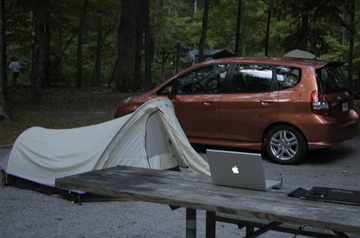
What am I doing, camping without an Airstream? Call it an experiment in minimalism, or a revisiting of my earlier camping lifestyle. Just don’t call it what it really is: a confluence of my cheapness and circumstances that prevented me from bringing the Airstream along. I’m in a rush to get back to New England, and taking my thrifty new car back with me. Since I’m using about 1/4 the gasoline that I would normally need to tow the trailer, I figured I’d go all the way and sleep in a tent as well. Reductio ad absurdum.
Tenting is also a way to reach campsites that RV’s can’t travel to. In the old days we used to carry 40 lbs of gear on our backs and hike far into the mountain ranges for camping. Now that we’ve had a taste of the places we can find in Arizona, I think we’ll want to do some tent camping and backpacking there this winter. An Airstream with a tent in the luggage compartment gives all the flexibility we could want.
So this is fun. My tenting experience will be brief this week, so I can enjoy the experience of sleeping on the ground knowing that I won’t have to do it every night. This reminds me of what other people who don’t travel full-time have to look forward to. In a way, it’s nicer to anticipate that fun camping weekend than it is to be “camping” every night of the week.
It’s also a nice change from the rally scene I left this morning. I like rallies, but I’ve decided that two weeks is too much for me. At some point the rally starts to become an analog for Burning Man, a massive experiment in group living. People start to drive faster on the grounds, boredom sets in, and pretty soon it’s just another big trailer park. Better to enjoy the offerings of the rally and then get out of town, I think.
And for me, it’s time to get home. The weather is reportedly poor, with thunderstorms expected daily, but still I want to see my family again and get going on a plan for this fall. We are debating three possible routes: east to Newfoundland, west to Montana, and straight southwest to Arizona. The final plan won’t be unveiled until August. But definitely, I plan to pack the tent and sleeping bags this time …
June 9, 2007 at 11:24 pm · Filed under Travel / lifestyle musings
Las Vegas is behind us now, along with the craziness of the Strip and all the hubbub of the business we had to do there. Finally, Eleanor and I are off on our own for a week, cruising America as we head east for the summer.
This is the first time we’ve been on the road without our daughter for over two years. It’s a strange feeling. I keep wanting to look in the mirror and see her in her car seat, but for once the seat is empty and there’s just the two of us on the highway. No longer Mom & Dad, we are once again Rich and Eleanor.
So our avowed purpose along the way is to enjoy all those little pleasures that are often denied to parents on the road: fast starts in the morning, long quiet stretches in the car, movies with ratings above PG in the evening, uninterrupted adult conversation, and naps.
Yes, naps. I used to have a perfected technique for power-napping just a few minutes at a time, but with an active child around I rarely get to exercise it. When the car stops, she wants to get out and run around, and there’s no chance for Dad to take a quick snooze even though we have a rolling bedroom in tow.
Ah, but now the opportunity arises. The past week in Las Vegas has been hectic and frankly we haven’t gotten as much sleep as we would like. So today we celebrated the end of the week with brunch (with Brett and our friend Kelly) at Caesar’s, then hitched up the Airstream and towed it about 200 miles north into Utah … and then we took a nap.
It turns out that having an Airstream trailer behind you is the perfect arrangement for naps. Late in the afternoon when the conversation dried up, my eyes got weary, and Eleanor’s head was dipping toward her chest, we pulled over into a truck stop somewhere in southern Utah and climbed into our extremely inviting foam bed.
You wouldn’t think a truck stop was the perfect place for a nap, but it can be. This particular spot was surrounded by magnificent mountain ranges, and the sun was just beginning to cast a golden glow all around. There were only a few trucks in the lot, and we were able to find a quiet corner. Being up around 5,000 feet, the air had cooled from the mid-90s of Las Vegas to a comfortable upper 70s. We turned on the vent fan for a soothing backround hum and gentle breeze, cracked a few windows to let in the fresh air from the surround meadows, and settled in for 90 minutes.
This may not seem like much, but this was a perfect, sublime, experience for us. No one there to wake us, no schedule to keep, just a spur-of-the-moment choice to lie down and enjoy the familiar peace of home … somewhere in Utah.
After the nap, refreshed but still sleepy, we cracked open a Starbucks frappucino, poured it over ice from the freezer, and picked up the trail again along I-15. Having crossed a time zone, we find ourselves reporting to you from somewhere near Provo UT well past 11 p.m. local time. For a day in the car, it has been very nice and I’m looking forward to another schedule-less day on Sunday.
March 14, 2007 at 9:15 pm · Filed under Places to go, Travel / lifestyle musings
We were warned about coming to Mexico. “I wouldn’t take my family there!” “You’re crazy to take your car/Airstream into Mexico!” “You can’t take guns there!” “What about the mordida (bribes)?” “Have you had a Hepatitis shot?” And of course, the perennial favorite “¦ “Don’t drink the water!”
The nay-sayers were out in force in the months before we came here. A dozen conversations we had with well-meaning friends can be summarized as simply, “Don’t go. It’s too dangerous.” But none of these people had ever camped in Mexico, indeed, few of them had ever crossed the border.
Many other people said “You’ll love it!” and recommended places to go. All of these people had been to Mexico numerous times. Many of them were in their 60s and 70s and felt safe traveling alone. Quite a few spent months camping in Mexico each winter. We chose to listen to these people because they had the benefit of actual experience.
We did not find a single person who had a first-hand tale of “banditos” or violent crime, and very few had ever gotten sick. It turns out that the banditos are a piece of folklore, about as relevant as tales of Billy The Kid to today’s traveler of Mexican highways.
The two books I consulted on the subject were also reassuring. “Traveler’s Guide to Mexican Camping” said, “People in border campgrounds will warn you not to cross into Mexico because there are banditos, dishonest cops, terrible roads, and language and water problems. The one thing you can be sure of when you get one of these warnings is that the person has not tried Mexican camping for him/herself.”
The “People’s Guide to Mexico” went into even more of a tirade on the subject, too long to quote here. But it was clear from our research, and our recent days in Organ Pipe Cactus National Monument, that we were not about to experience anything nearly as bad as the hazards and crime found on the US side of the border.
Puerto Peñasco is not part of the deep innards of Mexico. It’s a small town on the eastern shore of the Sea of Cortez, only 65 miles from the border. It is also known as Rocky Point by Americans, although that’s not its proper name. Being so close and convenient to the USA, it’s a huge spring break draw this time of year, and so popular with Arizona residents that it is sometimes referred to as “Tucson Beach.”

It hardly feels foreign, with the thousands of US residents filling the RV parks, hotels, restaurants and beaches. Everyone in the tourist-related businesses seems to speak English, dollars are accepted in many places, there are lots of English signs, and services in the RV parks are pretty similar to the US standard. It’s an easy place to visit even for someone who has never set foot outside of the US or Canada before.
Being a tourist town that caters to college students on spring break, most things are geared to serve clueless Americans. We overheard a group of them coming through Organ Pipe Cactus National Monument, telling the ranger they were headed to “that Mexico place.” When she asked which place, they said, “You know, that place in Mexico.” With that sort of knowledge and preparation coming across the border, you can imagine the patience the residents of Puerto Peñasco must have to deal with their customers.
I like to dive into the local scene in a foreign country, and the easiest way to do that is to join the local economy. Hit a grocery store, drop in on the market that doesn’t cater to tourists, or buy lunch from a street vendor or small off-the-beaten path bakery. Today, after Ken & Petey bought us a nice lunch at Playa Bonita Resort on the beach, where the menus and service were in English, I went out to see if I could do a little local business.
My short trip started with a stop at the local Banamex for some pesos from the ATM. Even though the machine only “spoke” Spanish, ATMs are the same the world over, so this was no challenge at all. However, it was interesting to observe the people using the ATM ahead of me: a security guard from a resort, a college student trying to get a cash advance on his US credit card, and an American couple who didn’t realize that in Mexico the “$” sign is used to denote pesos. Thus they were a tad confused that the machine would dispense as much as $5000 at a time. (To approximately convert pesos into dollars, divide by 11.)
I spent 300 pesos at the local Telcel store, buying a Telmex pre-paid SIM card for my spare GSM phone. GSM is the type of cell phone network used most widely in Mexico. Although US cell phones will work in some places, the technology they use is not as widespread. My US-based Verizon phone, for example, reports only an analog signal and not much of that. The Telmex SIM gives my GSM phone a Mexican phone number, so we can make calls in Mexico as inexpensively and easily as the locals do. This will be useful on future trips.
The final stop was to put 100 pesos of gas in the truck. Since Pemex stations sell in liters it can be confusing to determine how much gas you’ve bought, but with a calculator it’s pretty simple to do the conversion. How much gas does 100 pesos get you? Answer: Not much.
The fun part of doing these little errands is that nobody I encountered spoke any English, and so I was forced to communicate with universal tools. These include a smile, a polite and self-deprecating demeanor, as many words of the local language as I can conjure, hand gestures, and endless patience. With these tools I have successfully communicated with speakers of French, Italian, Spanish, German, and Portuguese, and even Czech. I don’t speak any of those languages. It is a very satisfactory feeling to manage to conduct even a minor transaction (such as buying gasoline) with only a smile and a few words, and I think the person on the other end of the transaction usually feels the same way.
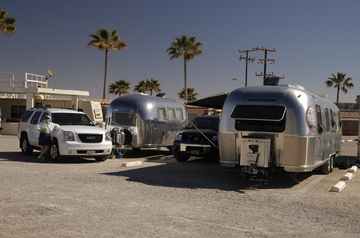
Our campsite next to Ken & Petey at Playa de Oro
Google Earth location of Playa de Oro campground.
There are several RV parks right along the beach, and we’re in one of them: Playa de Oro. This place is located south of the Old Port, near a lot of tourist “restaurant-bar” spots (emphasis on BAR, especially this month). The park is 320 tightly spaced full-hookup sites on a crushed shell surface and no view except on the beachfront sites. At night the restaurant-BARs turn on their music and we get a free, somewhat muffled, concert of dance music until about 2:30 a.m. Last night it was noisy but not unbearable, and we managed to sleep through it.
We don’t know if the water in this campground is safe to drink, but we arrived with a full tank (39 gallons) of fresh water and it should last for the four days we will be here, with conservation. If not, a vendor drives by daily in a pickup truck loaded with 5-gallon jugs of agua purificada, and when he honks his horn all we need to do is wave to him and buy a jug, just like we would for an ice cream truck. As a result, we have not connected to the water spigot at our site.
Similarly, we have avoided using the AC power. I tested the power outlet for correct wiring (ground, polarity, hot/neutral) using the simple tester that Airstream provides with every new trailer, and it passed. That’s more than I can say for some US parks, most recently one in New Mexico we stayed at. However, my voltage tester is dead, so I can’t verify whether the current is in the safe range for running certain appliances, like the air conditioner. Mexican campgrounds have a reputation for wildly fluctuating voltage, sometimes dropping during the day and rising at night, or spiking without warning.
As in other desert locations, there’s endless sunshine, so our strategy is to simply not plug in except for a few minutes in the morning to run the coffee pot. With the cool sea breezes we don’t need air conditioning anyway, and the solar panels are supplying more than enough power each day to fully replace what we use at night. My laptop, which comes out only once every other day to record my musings, is running off DC power and is thus insulated against variances in the AC voltage.
For the various comforts and liabilities listed above, we are paying $19 per night, which is very reasonable by US standards for a spot about 200 yards from the beach. In Fort Myers Beach, for comparison, a similar site cost $52 per night, although the beach was prettier. The beach is not bad here but certainly not up to the gorgeous sugar-white standard of the Florida barrier islands, and not quite as nice as the beaches north of town, which are wide, shallow, and uncrowded even during Spring Break.
The water is reasonably clear, if somewhat cold, and the beach is a coarse tan sand which at low tide reveals shelves of the underlying volcanic basalt. Anyone on the beach will soon encounter all types of beach vendors, selling “Cuban” cigars, jewelry, trinkets, and other assorted junk. Not one so far has offered us the stuff one might expect on the beach: cold drinks, sunscreen, parasols, folding chairs, inflatable beach toys, or kites.
February 14, 2007 at 10:12 pm · Filed under Travel / lifestyle musings
A lot of people commented to me privately about our house hunting process. Interestingly, nobody begged us to stay on the road and not buy a house. I’m interpreting that as meaning that our friends are supportive — rather than a hint that we are on the road too much!
Of course, you already know we won’t get off the road permanently. My intention is to keep the blog going for a long time. We also haven’t bought a house yet, although we are deep in discussion about it.
Whether we do or not, we have some very interesting plans for this fall that I’ll share with you later, once they firm up. But here’s a hint: I’ve been buying books to plan the next major expedition …
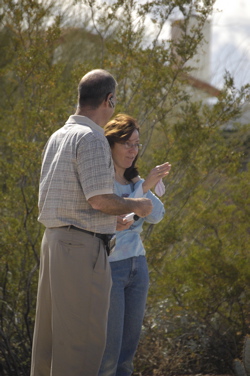
Eleanor and our real estate agent chat about a house
In the meantime, I have been thinking about how we got started on this adventure, and what we’ve learned. Most people who have RV travel experience already know that traveling this way is not like the average person’s view of travel. I’ve always winced when people refer to us being “on the road” because it rarely feels that way.
“Travel” evokes images of glamour and suffering: exotic locales arrived at through uncomfortable means of conveyance. The constant uncertainties and dependencies inherent in traditional travel will wear you out. As someone once said, travel is like cream: broadening but too much will make you feel sick.
By contrast we mostly float seamlessly through the country, courtesy of our Airstream. It often doesn’t feel like travel at all. I know that’s hard to believe, but keep in mind that we couldn’t possibly have lasted this long (16 months at present) if this had really been just one big road trip. It’s a lifestyle.
The only time I feel that old familiar feeling of rush-rush travel is when we need to fly somewhere … as this week. We are still monitoring Emma closely for signs of congestion that would prohibit her flight on Thursday, and there’s a heavy load of snow in the northeast that shut down half a dozen major airports today. Eleanor has been pressing hard to complete her obligations today and be ready for an early departure, all the while wondering if they’ll even be able to go. It’s a pain.
I’ve moved my flights. The congestion is clearing only slowly, and I doubt I’ll be ready to fly on Friday, so now my flight is Tuesday. Hey, I could drive to Florida by then … but I think I’ll just sit here instead and enjoy a rare few days alone in the Airstream. Hmmm. … maybe a few movies, some good guy chow, and Rich C and I can hang out for a while. He’s right across the park. Or maybe the Titan Missile Museum this weekend.
February 13, 2007 at 10:00 pm · Filed under Travel / lifestyle musings
We seem to dividing our days three ways: working, hunting for houses, and lying in bed. Actually, I’m doing most of the lying in bed since I seem to have the worst of the virus. (I can hear all you women saying, “Oh, men are such babies when they get sick!”) But really, Emma seems perfectly fine and Eleanor is bogged down a little but pretty functional.
I’ve shaken the cold but the sinus congestion hasn’t cleared, and I’m afraid it may be another week before I can fly, which means there’s a good chance I’ll have to stay here and miss the Florida State Rally. E&E should be good to fly, and their major worry is snowstorms in the northeast.
The house hunting is going well, perhaps too well. We’ve found two houses we like. Now the problem is deciding to commit to one or keep looking for something even better. That’s a hard call.
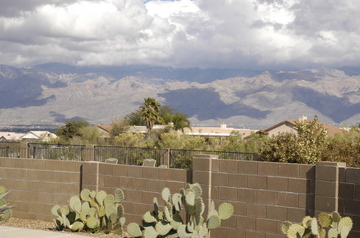
View of the Santa Catalina Mountains from one of the houses we are considering
It’s also hard to face coming off the road. I was exchanging email a couple of days ago with Leigh of www.63flyingcloud.com and she made a similar comment. Leigh and Brian are preparing to build a house after 600 days of full-timing. Leigh said, “The problem with 2 years on the road, is the idea of being stationary anywhere for more than 3 months is pretty unappealing.”
We could make an offer on a house tomorrow and be in it next month. But obviously we’re not driven to that, because we haven’t made an offer despite having found good houses. It’s interesting that the full-time lifestyle is so appealing — even with its many compromises — that we find ourselves hesitating to re-enter the traditional world.
But it is inevitable. We need to establish a base camp. The compromise will be that we won’t settle down fully. We’ll be on the road, and in the Airstream, for probably 4-5 months a year, including all summer.
On our way back from house hunting the GPS suggested a shortcut. This should be a good lesson to those of you who trust your GPS a bit too much. Sometimes they don’t know what’s best. In this case, the GPS sent us to a road clearly marked “DEAD END”, but we decided to pursue it anyway because the road did continue in the form of a very bumpy dirt trail down a hill into a wash.
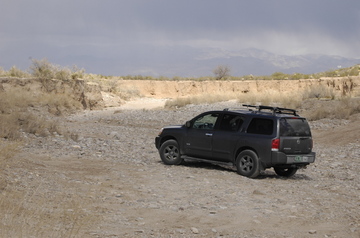
Hey, what’s the point of having a high-clearance vehicle with 4WD if you don’t have some fun with it once in a while? The road eventually bottomed out in the wash and we took a short drive in it, and then continued onward. The GPS was right, it was a shortcut … but not one I’d recommend without plenty of ground clearance.
February 9, 2007 at 8:50 pm · Filed under Travel / lifestyle musings
Uh oh. I thought I’d get through this winter without a cold, but — zing! — someone got me.
E&E seem mercifully unaffected, at least so far. In the confined space of a trailer it is amazing that we can all co-exist without spreading colds to each other, but somehow we manage to do it. I am really hoping they stay healthy, because they’ve got to fly on Thursday. Emma won’t make it if she’s congested.
I also have to fly, on Friday, so I’m dosing with Zicam and hoping for the best. But if I must have a cold, being in the desert with warm temperatures and lots of sun is the best place I can imagine.
So what if we had been in a less conducive situation? For example, imagine we were midway through a drive down the Natchez Trace, or Blue Ridge Parkway, or up the Dempster Highway in Alaska? Well, our experience has been that there’s always somewhere to pull over and park it for a while. The spot may not be your first choice, but at least with the rig you’ll have a warm bed, food in the fridge, and the other comforts of home, even if you are just hanging at a truck stop.
This is partially why we always travel with plenty of supplies: water, food, propane, etc. Even without many illnesses we’ve had many a day where an impromptu stop was either required by circumstances or chosen just for fun. From talking to other RV’ers I know that many leave their water tank empty (to save weight, usually) while towing, but we never do that, and many times we’ve been glad to have the water.
Unexpected stops seem to be a part of this life. Planning is great but it’s no guarantee. We’ve had plenty of unexpected stops. Most have been by choice, but we’ve also had some because of weather, mechanical breakdown, getting a late start, and illness. The trick of course is to find the opportunities in every stop, and revel in “adventures” even if they aren’t exactly what you set out to do.
OK, what was a talking about? See, that’s what happens when I get a cold. Last year’s cold was in San Diego and it was a doozy. Since my brain has gone to mush, perhaps you can flick over to that blog entry and entertain yourselves reading the Archives while I get better.
« Previous entries ·
Next entries »







